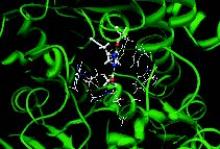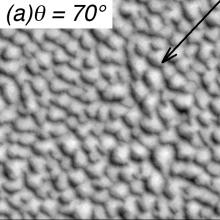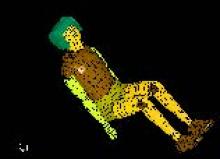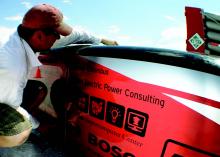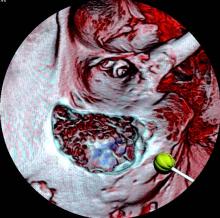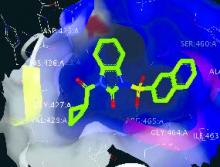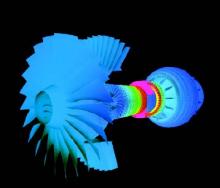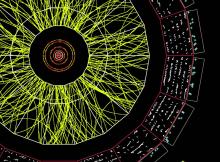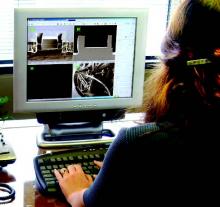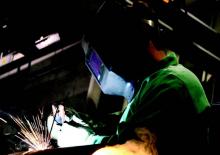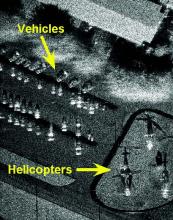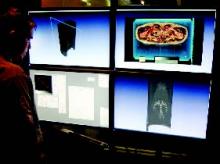Ohio State University chemistry professor Christopher Hadad, Ph.D., is developing measures that will stop, or even prevent, the effects of lethal chemical warfare agents such as the nerve agent sarin. At the center of his research are organophosphinates (OPs), extremely toxic chemicals that attack the central nervous system and can cause deadly convulsions.
2007 Research Report
By employing molecular dynamics simulations, an Ohio State University researcher is investigating how DNA is damaged by ultraviolet (UV) light.
The research of Ohio State University physicist John Wilkins, Ph.D., examines how complex structures form in nature.
Among several interests studied by University of Toledo physicist Jacques Amar, Ph.D., are the processes behind epitaxial thin-film growth, in which the crystals of the film are aligned with the underlying material.
A soldier’s ability to survive a mine blast greatly improves if armored vehicles are equipped with energy-absorbing seats, according to recent studies by Ala Tabiei, Ph.D., an aerospace engineer at the University of Cincinnati.
Buckeye Bullet 2, the world’s first land-speed race research vehicle powered by hydrogen fuel cells, is designed and built by students at The Ohio State University’s Center for Automotive Research.
Their goal? To beat the U.S. land speed record for its category set by the first Buckeye Bullet in 2004.
The acronym VM2M might stand for Virtual Microscopy to Microarray, but for cancer researchers it means revolutionizing a part of the investigative process.
Expert pathologists depend on microscopy, or the latest use of microscopes, to examine and review diseased tissue. Their conclusions help oncologists form the foundation for treatments.
Gregory J. Wiet, M.D., a pediatric otolaryngologist, head and neck surgeon at Columbus Children’s Hospital, and experts at the Ohio Supercomputer Center developed a virtual simulation tool that teaches medical residents temporal bone surgery.
The Genome Research Institute Discovery Platform, or GRIDP, provides Ohio academic researchers and educators with a user-friendly way to tap into the emerging field of computational drug discovery, encompassing bioinformatics, computational biology, and computational chemistry.
With the Computational Chemistry Grid, chemists can focus on their science, not the nuts and bolts of their computing.
Aerospace engineers such as Ohio State University professor Jen-Ping Chen, Ph.D., depend on modeling and simulations of turbomachinery, the alternating sections of spinning and fixed blades in a jet engine’s compressor and turbine, because the multiple stages and extreme temperatures make it difficult to conduct experimental measurements.
Using the high performance computing and support resources of the Ohio Supercomputer Center, Ohio State University Earth scientist Doug Alsdorf, Ph.D., and his colleagues successfully predicted flooding patterns for 5,000 square miles of the central Amazon floodplain.
The ALICE experiment, short for A Large Ion Collider Experiment, is a massive effort to study the birth of matter involving a collaboration of more than 1,000 physicists, engineers, and technicians from 30 countries. The Ohio Supercomputer Center serves as a key resource for hosting data and analysis codes in North America.
The Ohio Supercomputer Center and its partners are enabling researchers around the state and beyond to remotely access some of Ohio’s most valuable and expensive scientific instruments over the Internet.
Engineers at heavy-manufacturing and energy industries today have access to a new online welding simulation tool, E-Weld Predictor, thanks to the Ohio Supercomputer Center’s Blue Collar Computing™ initiative and a partnership between OSC and Edison Welding Institute (EWI).
Blue Collar Computing™, an initiative of the Ohio Supercomputer Center, helps take the same supercomputing systems and applications used almost exclusively by Fortune 500 companies and makes them scalable, accessible, and affordable to small- and medium-sized companies.
Surveillance of the ground by air- and space-borne sensors has proven to be essential to military and intelligence organizations. Specifically, the U.S. Department of Defense’s 2006 Quadrennial Defense Review highlights the need for “a highly persistent capability to identify and track moving ground targets in denied areas.”
A key element in enabling customers to use high performance computing technology is the ability to access supercomputing systems in a simple, straightforward manner.
While continued developments in processing speeds and disk densities improve computing over time, the most fundamental advances come from changing the ways in which components interact.
Due to the cost of network processing, high-end Web servers in the near future will be unable to handle the continually increasing demand of more clients ever hungrier for more content. In fact, it is already commonplace today to use multiple servers to host a single Web site.
Supercomputers are only as useful as the software they can effectively run. In order to expand that base of software, it must be easier to write and debug code on massively parallel systems.
Veterinary schools nationwide are continually seeking new methods to reduce the use of live animals in surgical training. Yet, the question remains whether this reduction negatively affects the surgical proficiency veterinary students and residents require prior to graduation.
The gaming industry, with its consumer demand for realistic, smooth, 3-D images, is without a doubt advancing the graphics hardware market exponentially. In recent years, commodity-based graphics chips or graphical processing units (GPUs) have become more programmable and easier to use for general purpose applications (GPGPU).
High-definition videoconferencing (HDVC) is rapidly becoming an alternative to the traditional standard-definition videoconferencing systems for applications in fields as diverse as education, health care, justice, and entertainment.
Students at nine Ohio college and university campuses began adding valuable computational science skills to their academic portfolio with the August launch of a new, virtual minor program being coordinated by the Ralph Regula School of Computational Science.
The Ralph Regula School of Computational Science (RRSCS) is a statewide virtual school focused on computational science - the use of computer modeling and simulation to solve complex business, technical, and academic research problems.
